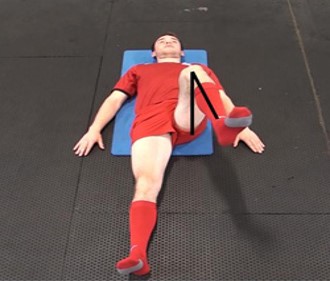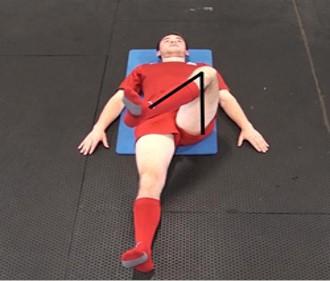Hip External and Internal Rotation Range of Motion Test
Assessing internal and external hip rotation helps indicate whether the player has:
- Normal range of motion about the hip
- Restricted range of motion about the hip
Procedure
Here we present a supine position for hip internal and external rotation assessment. According to Reiman & Manske in 2009, to administer the test, the player lies supine (face up) on the floor with one leg extended and the other flexed to 90 degrees at the knee.
When administering this test, it is important to establish a baseline position, which is parallel to the midline of the body as shown by the black line along the player’s thigh in Figure 1a and 1b. Then, with reference to this, the test administrator can estimate the degrees of rotation or preferably use a goniometer to attain a more accurate measurement. To examine internal range of motion, from the supine position, bring the player’s lower leg and foot outwards and as far away from their body as they comfortably can as shown in Figure 1a. From the supine position to examine external range of motion, bring the players lower leg and foot inwards across the body and other leg as shown in Figure 1b
Figure 1a. Example of limited ROM in internal hip rotation. Note that the normal internal rotation ROM is between 35-40 degrees. In the example above, the rotation is 28 degrees.

Figure 1b. Example of limited ROM in external hip rotation. Note that the normal external rotation is between 50-60 degrees. In the example above, the rotation is 45 degrees.

The evidence
According to Sahrmann in 2002, a restriction in either internal or external rotation may be a performance inhibitor for many players and it could also be a predisposing factor for injury. Having normal hip rotation allows for unimpeded movement about the hip. During play and tactical practice, the player will repeatedly move the hips internally across the opposite leg e.g. kicking, side-stepping or rotation in general or externally e.g. turning. Reduced internal rotation of the hip has been found in several sporting populations and has been either retrospectively or prospectively associated with injury. For example, Vad and colleagues in 2004 noted a relationship between low back pain and hip ROM deficits. Other authors such as Murray et al in 2009 have also noted a relationship between hip rotation range of motion and low back, chronic groin injury and acute adductor strains.
Hip Internal and External Range Of Motion Corrective Exercises
This test allows the coach to identify if the player needs to work on their internal or external rotation or both in order to improve their movement capability. The following are some corrective exercises that can be used to help players improve hip internal or external rotation.
To improve hip internal rotation:
Internal Rotation with Band Stretch
- Player attaches a band to a rack or a fixed anchor point
- Sits side-on to the band with legs stretched out in front
- Loops the band around their outside knee and bends the knee to place the foot on the ground
- Moves further away from the rack increase tension on the band
- Keeping their foot flat on the ground, player allows the band to pull their knee towards the rack into internal rotation
- Holds stretch for 30 seconds at a time.
Internal Mobilisation
- Player sits on the ground with knees bent and feet flat on the ground
- Drops the inside of the right knee to the sole of the left foot
- Repeats and reverses by dropping the inside of the left knee to the sole of the right foot
- Player tries to stay upright in the seated position throughout
- Holds stretch for 30 seconds at a time.
To improve hip external rotation:
Seated figure of 4 stretch (right hip)
- Player sits on a bench or chair and places their right ankle onto their left knee
- Pushes their right knee down towards the ground until a stretch is felt
- Repeats with their left ankle on their right knee pushing their left knee down
- For a deeper stretch the player can hinge at the hip leaning the torso forward
- Holds for 30 seconds at a time.
Pigeon stretch
- Player starts in a press-up position
- Brings one leg under the body aiming to get their lower leg as perpendicular to their body as possible
- Sinks the hips down to the ground until a stretch is felt
- For a deeper stretch, reaches their hands out in front of them
- Holds for 30 seconds at a time.